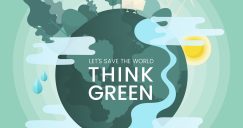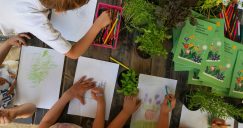Attending to equity
Transdisciplinarity, Imagination & Possibility

- Article, Educational resource, Research
The role of art and humanities in tackling the climate crisis cannot be in doubt. In the face of such a complex challenge, we humans can no longer work within disciplinary silos. Climate responses must be transdisciplinary, and educators must work with a range of emotions alongside data and evidence. Artists and creative practitioners play important roles in LEVERS, inviting us to move beyond the world as it currently is, and supporting participants and learners alike to imagine different possibilities for a sustainable future. Research shows that working in community on creative, collective climate action projects can change mindsets towards more positive emotions and reduce climate anxiety (Hurley & Roche, 2023; Stoknes, 2015).
LEVERS promotes the development of learning programmes that incorporate transdisciplinarity, imagination and emotions into climate justice projects, and create space for artistic exploration as well as scientific study.
Resource
Case Study: Corca Dhuibne Inbuanaithe
Corca Dhuibne Inbuanaithe A Creative Imagining was a creative climate action project based on the Dingle Peninsula in Co. Kerry, Ireland which involved a creative artist Lisa Fingleton working with ten farm families over the course of a year between January 2022 and January 2023. Read about the initiative here.
Resource: Creative Approaches to Climate and Peace Education - an educator's guide to using storytelling and art
Arts-based methods for climate education: Julia Bentz’s open access book ‘Creative Approaches to Climate and Peace Education – an educator’s guide to using storytelling and art’ is a valuable resource which centres regenerative themes: “Learning as a Journey, ”Hope and Imagination,” “Many Meanings of Peace,” “Healing Trauma and Creating Resilience,” “Connection and Community,”
Watch: From What Is to What If: why the next 10 years needs to feel like a revolution of the imagination.
From What Is to What If: why the next 10 years needs to feel like a revolution of the imagination. During his keynote address at the Ecsite Conference 2023, Rob Hopkins, founder of the Transition movement, shared his insights about the importance of nurturing the imagination in organisations and movements for change.
Watch: webinar on the use of art and science towards climate action
As part of the Climateeurope2 project, LEVERS partner organisation CPN delivered a webinar on the use of art and science towards climate action. The webinar brings together artists and scientists, as well as those working at the intersection of the two, to explore the potential for their collaboration and to reflect on how interdisciplinary approaches can yield new insights and solutions to enhance public awareness of climate change challenges.
Learn: konS ≡ PARK - Academy for contemporary investigative art
konS ≡ PARK – Academy for contemporary investigative art: is a network of creative hubs in Slovenia that uses peer learning to support young people and the public to change their understanding of science, technology and art and develop attitudes that help understand the dynamics of contemporary society. Stella Verde’s work is an interesting example. A second example is the development, together with artists of the mybot Σigma system for peer-to-peer learning in non-formal science education that leverages the power of artificial intelligence. Read more here.
Moving beyond the anthropocentric ideas of human relationships with nature or technology, artist Špela Petrič’s work PL’AI explores playful interactions between plants and an AI robot, positing the idea that the act of play is at the heart of self-knowing.
Read: Learning to live with Climate change: From Anxiety to Transformation & All We Can Save: Truth, Courage, and Solutions for the Climate Crisis
Learning to live with Climate change: From Anxiety to Transformation book by Blanche Verlie (2021, open access) All We Can Save: Truth, Courage, and Solutions for the Climate Crisis (2021, Johnson & Wilkinson (Eds.)), and the associated All We Can Save Project
Case Study: Introducing ideas of human-plant-machine communication in a youth learning programme,
Introducing ideas of human-plant-machine communication in a youth learning programme, LEVERS partner Kersnikova runs a three-hour workshop for learners aged between 9 and 15 years entitled DigiVrt (Digital Garden). DigiVrt asks how humans can help with getting the right amount of water to our plants?
The DigiVrt mechatronic watering system, has been designed so that a mini-garden will never dry out or drown. When the Kersnikova team designed the DigiVrt mechatronic watering system, they thought about the possibilities of mechanics and electronics in plant care.
Using a 3D modelling tool, learners in this workshop design self-sustaining ecosystems that enable small gardens in urban dwellings. First they learn about mechatronics – assembling a frame for a humidor and a water bottle, and connecting the electrical components so that they do not come into contact with water.
Then comes the programming and getting to grips with the code – based on the biology of different plants and their needs for successful growth, they program the Arduino microcontroller to send a watering signal when the plant needs water.
At the end of the workshop, they plant the frame with all the necessary mechatronics on the plant. Then all they have to worry about is the water supply in the bottle, and the DigiVrt takes care of the rest.









